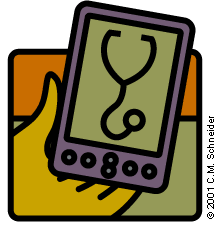
Over 20 percent of American physicians currently carry personal digital assistants (PDAs). Here’s how one puts his to use.
Fam Pract Manag. 2001;8(6):50-51

I first became familiar with palm-top personal digital assistants (PDAs) during residency. I was very much a cynic about how such devices would enhance the way I practiced medicine. I believed everything should be stored in the brain – at least until something better was invented. It’s now been almost three years since I bought my first PDA and, while it is in no way equivalent to a human brain, it’s the closest thing I’ve found so far. No wonder people call the PDA a “peripheral brain.”
The basics
Whatever brand of PDA you choose, it’s merely an electronic organizer until you add applications to it. But even as an organizer, I’ve found my Visor Prism (www.handspring.com) to be indispensable. It comes with a built-in date book, address book, to-do list and memo pad, and uses the Palm operating system (OS). The Palm OS platform provides access to the largest variety of medical applications available. With a personal history of poor penmanship, I have found it to be a much neater and more efficient way to keep track of addresses, phone numbers and my schedule; so much so that I no longer use any type of paper address or appointment books. The built-in to-do list is intuitive, with the capability to rank tasks and track due dates. As someone always in need of a reminder, I find this function indispensable. I use the memo pad function during meetings and grand rounds, mainly for jotting down pearls and brief notes for later review or recall.
Useful applications and Web sites
In addition to these built-in functions, my PDA also comes equipped with 8 MB of memory, not to mention a memory expansion slot, giving me plenty of room to download the clinical information I use at the point of care. One of the best databases I’ve found is ePocrates qRx and qID (www.epocrates.com). It takes approximately 1.5 MB of memory and provides adult and pediatric medication dosages by indication, potential interactions, contraindications and adverse reactions, not to mention current drug prices and mode of action. By using the AutoUpdate feature and simply pressing a button, new clinical drug information is automatically added to the database through the Internet. Best of all, the program is free to registered users.
Although there is an enormous amount of medical information available for downloading to a PDA, I choose to bring the following to the bedside with me, starting with two textbooks I have found essential for quick reference: Griffith’s 5-Minute Clinical Consult 2000 and The Merck Manual of Diagnosis and Therapy, Centennial Edition. I purchased both at www.handheldmed.com for $64.95 and $79.95, respectively.
Many other texts are available for the Palm OS, some for free. However, many of the texts are memory intensive (e.g., the Merck Manual requires 4 MB), which is why I recommend a PDA with at least 8 MB of memory and the potential for expansion.
MedCalc (free; www.calc.med.edu). This little program calculates complicated formulas such as creatinine clearance, fractional clearance of sodium and maintenance intravenous fluids for pediatrics. I also use it in the outpatient setting. For example, I use the body mass index calculation to discuss the risk and benefits of weight loss with patients. This program also allows storage of individual patient information for later recall.
iSilo ($12.50; www.isilo.com). Every PDA user needs a document reader. They enable users to view “doc” files such as books, medical files and other simple text documents downloaded from the Web. I prefer iSilo because it uses less memory than many other document readers. There are literally hundreds of free doc files available for personal use. MemoWare (www.memoware.com) offers PDA users an extensive variety of references (both doc files and databases) specially formatted for the Palm OS platform. My favorites include “A Guide to Contraceptive Choice” and “A Pocketful of Prevention.”
PregCalc 3.7 Professional ($20; www.thenar.com). This handy application is great for the family physician with an extensive prenatal practice. It calculates estimated delivery date from last menstrual period (and vice versa), gestational age from ultrasound data and much more. It also has the ability to store information for use during future patient encounters.
HanDBase ($24.99; www.ddhsoftware.com). One of the initial reasons for my first PDA purchase was procedure tracking. I was frustrated because although I always intended to write down patients’ information later, I didn’t always do it. HanDBase solved this problem for me. With it, I can create or customize databases to record or track just about anything. I can also take data stored on my desktop personal computer and transfer (“hot sync”) it to my PDA so that I can read or add information while I’m away from my PC.
JournalToGo (free; www.journaltogo.com). It seems I never have adequate time to read medical literature. This Web site lets me download peer-reviewed journal abstracts to my PDA and do literature searches. Although it’s not a complete substitute, I’ve found it has helped keep me current while I’m on the go.
Patient response
I find myself using my PDA more frequently these days. Often I use it before prescribing a new medication to assess any potential interactions with a patient’s current medications. I also use it to get a feel for how much the medicine I want to prescribe will cost, since many of my patients are on tight budgets. My patients are curious about my PDA and when I explain what it’s for, many have told me they appreciate that I’m looking out for their best interests.